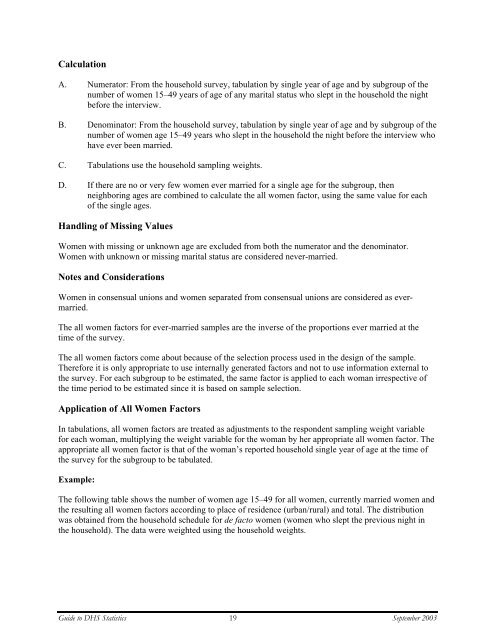Demographic and Health Surveys Methodology - Measure DHS
Demographic and Health Surveys Methodology - Measure DHS
Demographic and Health Surveys Methodology - Measure DHS
Create successful ePaper yourself
Turn your PDF publications into a flip-book with our unique Google optimized e-Paper software.
CalculationA. Numerator: From the household survey, tabulation by single year of age <strong>and</strong> by subgroup of thenumber of women 15–49 years of age of any marital status who slept in the household the nightbefore the interview.B. Denominator: From the household survey, tabulation by single year of age <strong>and</strong> by subgroup of thenumber of women age 15–49 years who slept in the household the night before the interview whohave ever been married.C. Tabulations use the household sampling weights.D. If there are no or very few women ever married for a single age for the subgroup, thenneighboring ages are combined to calculate the all women factor, using the same value for eachof the single ages.H<strong>and</strong>ling of Missing ValuesWomen with missing or unknown age are excluded from both the numerator <strong>and</strong> the denominator.Women with unknown or missing marital status are considered never-married.Notes <strong>and</strong> ConsiderationsWomen in consensual unions <strong>and</strong> women separated from consensual unions are considered as evermarried.The all women factors for ever-married samples are the inverse of the proportions ever married at thetime of the survey.The all women factors come about because of the selection process used in the design of the sample.Therefore it is only appropriate to use internally generated factors <strong>and</strong> not to use information external tothe survey. For each subgroup to be estimated, the same factor is applied to each woman irrespective ofthe time period to be estimated since it is based on sample selection.Application of All Women FactorsIn tabulations, all women factors are treated as adjustments to the respondent sampling weight variablefor each woman, multiplying the weight variable for the woman by her appropriate all women factor. Theappropriate all women factor is that of the woman’s reported household single year of age at the time ofthe survey for the subgroup to be tabulated.Example:The following table shows the number of women age 15–49 for all women, currently married women <strong>and</strong>the resulting all women factors according to place of residence (urban/rural) <strong>and</strong> total. The distributionwas obtained from the household schedule for de facto women (women who slept the previous night inthe household). The data were weighted using the household weights.Guide to <strong>DHS</strong> Statistics 19 September 2003








![Obtaining Informed Consent for HIV Testing [QRS4] - Measure DHS](https://img.yumpu.com/49850117/1/190x245/obtaining-informed-consent-for-hiv-testing-qrs4-measure-dhs.jpg?quality=85)







